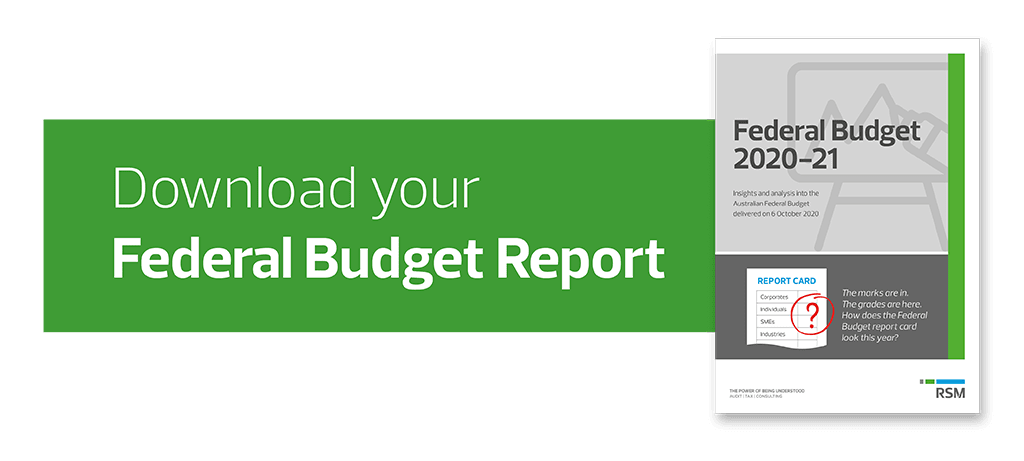What does the 2020-21 Victorian state budget mean for you and your business?
The Victorian Treasurer, Tim Pallas MLA, recently handed down the Victorian State Budget for 2020-21. In line with the other Australian States and with the Federal Government, this budget was delayed from the usual May timing.
T here is no doubt that COVID-19 has had a significant effect on Victoria and Victorians. The economic impacts of the extended lockdown have and will continue to have a significant effect for time to come. This can be seen in the economic projections given by Treasurer Pallas:
here is no doubt that COVID-19 has had a significant effect on Victoria and Victorians. The economic impacts of the extended lockdown have and will continue to have a significant effect for time to come. This can be seen in the economic projections given by Treasurer Pallas:
- Gross State Product to decline by 4%.
- Revenue down by 4.2%, including State Tax Revenue down by 11.3%.
- Victoria’s deficit is expected to reach $23.3bn this year, reducing to $5.9bn in three years.
- Net Debt is expected to be $87bn this year, reaching $155bn by June 2024.
These are significant numbers, which in the Government’s opinion are needed to support Victoria in getting back to normal. They also underpin the spending required to support businesses in creating jobs which will in turn stimulate the Victorian economy.
Key points | The jobs plan | Tax relief | Infrastructure spending | Innovation | Industry support | Health
Key points
- The Victorian Government’s central platform is job creation.
- This will be supported by spending in key industries along with some tax-related measures for small and medium enterprises.
- State debt will increase to support funding these measures.
The jobs plan
The key platform of this Budget is Victoria’s Jobs Plan.
As a result of COVID-19, unemployment in Victoria has increased as a result of many Victorians either losing their jobs or having their work hours reduced. The Victorian Government is embarking on a process to get Victorians back into work.
The Jobs Plan seeks to create an additional 400,000 jobs by 2025, with an interim milestone of 200,000 additional jobs by 2022.
The Jobs Plan focusses on four key elements:
- Supporting Victorians returning to work;
- Investing in infrastructure to create jobs;
- Support for industries, including new investment and tax incentives; and
- A regional approach, ensuring that priorities are targeted at local strengths and challenges.
Each of the Government’s spending measures ties into the Jobs Plan.
A key element of this plan is the Secure Work pilot scheme released by Victorian Premier Daniel Andrews MLA earlier this week. The pilot will run for two years and will provide up to five days sick/carer’s leave at minimum wage for casual employees in selected industries. The relevant industries will be determined based on consultation with workers, industry, and unions, to which the Government has pledged $5m for the consultation.
 Tax relief
Tax relief
Aside from the measures specifically targeted at certain industries, the Government has announced a package of measures applicable to business more broadly.
To assist with the creation of Victorian jobs, a New Jobs Tax Credit will be given to encourage small and medium businesses to re-employ and engage additional staff. Businesses with a total Australian payroll of less than $10m will be eligible for a non-refundable payroll tax credit of 10 cents for every $1 of Victorian wages paid in 2020-21 and 2021-22 above the previous year’s wages. This is estimated to save businesses $836m, support 9,400 jobs, and assist 14,000 businesses in 2020-21 and 21,000 businesses in 2021-22.
In addition, the Victorian Government will raise the threshold for remitting payroll tax annually from $40,000 to $100,000. This will apply from 1 July 2021 and is expected to provide cash flow support of $309m to around 7,000 businesses.
Infrastructure spending
The Victorian Government has committed over $10bn in spending on roads and public transport. This includes projects such as:
- $2.2bn for pre-construction works on the new Suburban Rail Loop, including the creation of 20,000 jobs during the course of the project (including 2,000 apprenticeships, traineeships, and cadetships);
- $2.0bn for Stage 1 of the Geelong Fast Rail project;
- $1.5bn for the purchase of new trams and the establishment of a new maintenance facility in Melbourne’s northwest;
- $255m to upgrade the Great Ocean Road and inland routes, also aimed at supporting regional tourism; and
- $17.4m for upgrading freight and supply chain road networks.
In addition, the Victorian Government has announced spending on other infrastructure including:
- $1.24bn for schools and TAFEs;
- $498m for the public, community, and social housing facilities;
- $382m for local sport and tourism; and
- $359m for transport infrastructure repairs and maintenance.
Housing & property
The Government has committed $500m through the Victorian Home Buyer Fund to assist Victorians to enter the housing market. This Fund will contribute to the purchase price of a house in exchange for a proportionate equity interest in the property. This will reduce the deposit required by home buyers and will apply to both established and new housing.
In terms of new housing, the Government will provide a 50% land tax discount for eligible new developments until 2040 to support the Build-to-Rent sector. Eligible developments will also be exempt from Victoria’s Absentee Owner Surcharge over the same period.
The Government has also announced a land transfer duty waiver of 50% for new residential properties and 25% for established housing for purchases of up to $1m made before 30 June 2021. The aim is to stimulate activity in new housing development, with the flow-on effect of creating more Victorian jobs. This is in addition to the previously announced extension to Victoria’s $20,000 First Home Owner Grant for purchasing new residential property in regional Victoria.
These measures are also in addition to the previously announced 50% land transfer duty concession for Victorian commercial and industrial properties, which will apply to contracts entered from 1 January 2021 (rather than 1 July 2023 as announced in the 2019-20 Budget).
Innovation
Innovation and support for start-ups is another key focus in this Budget. In this regard, the Victorian Government has pledged support for this sector in the following terms:
- $2.0bn for the Breakthrough Victoria Fund, to drive investment in translational research, innovation, and commercialisation, focusing on industries including health and life sciences, agri-food, advanced manufacturing, clean energy, and digital technologies. This Fund is expected to create more than 15,000 jobs over the next 10 years;
- $210m for medical research, a big part of which is research into COVID-19 treatments and responses to short-medium and long-term impacts;
- $75m for regulatory reform initiatives, to facilitate innovation and reduce the cost of doing business;
- $61m for the Victorian Start-up Capital Fund, designed to support high-growth start-up entities to scale and support jobs; and
- $60m for a Manufacturing and Development Fund, which will support Victoria’s manufacturing and industry capability.
Industry support
The Government recognises that one of the hardest-hit sectors of the Victorian economy is the tourism industry. As a result, the Government announced a package to restart marketing and stimulate activity. This includes:
- $150m for a Regional Tourism Investment Fund aimed at increasing tourism and leveraging major private sector investment;
- $149m for regional tourism infrastructure, campsites, and visitor amenities projects;
- $107m to support strategic destination planning, including marketing campaigns and funding for regional tourism boards;
- $28m for a new Victorian Regional Travel Voucher Scheme;
- $20m for regional events; and
- $9.7m for business events, which attract significant visitors to Victoria during the off-peak and shoulder seasons.
 Health
Health
Victoria’s healthcare sector has come under significant pressure this year. This not only includes the hospital system caring for the many Victorians who contracted COVID-19, but also the flow-on mental health impacts. The Budget provides $9.0bn in additional funding to health sciences and infrastructure. This includes:
- $2.8bn to maintain hospital capacity;
- $869m for mental health capacity, including providing an additional 155 public mental health beds across the state;
- $121m to deliver additional healthcare to patients at home; and
- $33m for cancer treatment.


